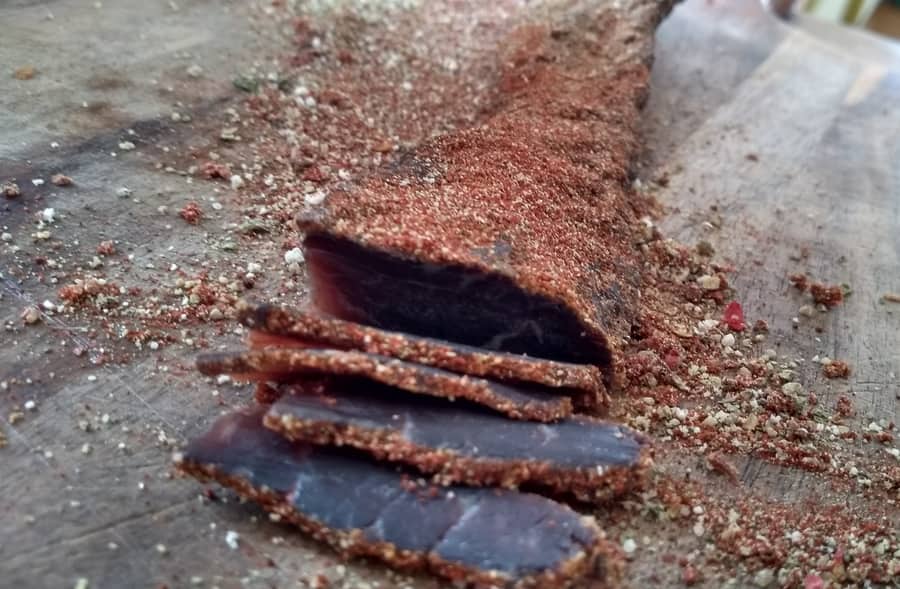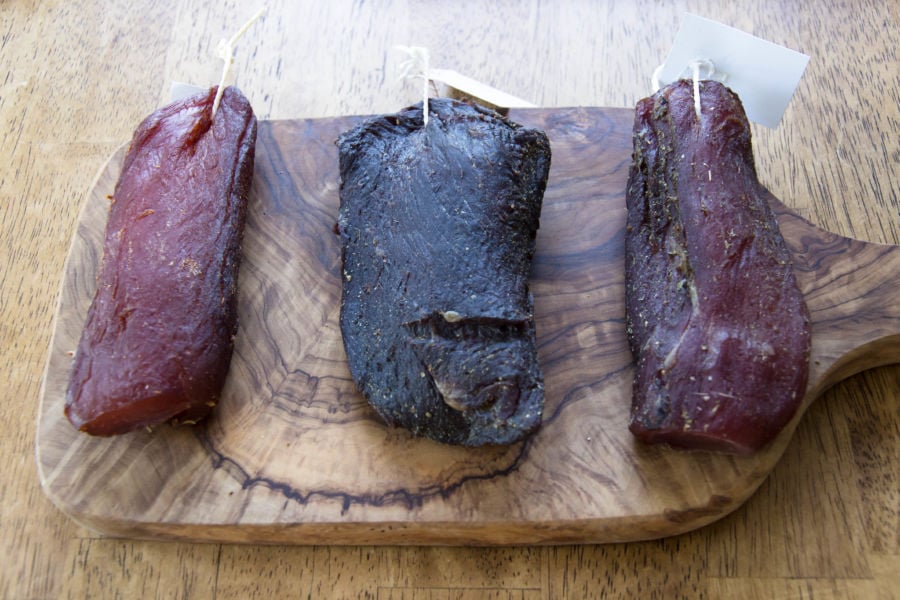I take cured meats camping and fishing often and love the outdoors. I want to help you see why certain cured meats are perfect for your journeys and adventures.
I’ve used most cured meat styles from around the world and share what’s actually worked for me in the backcountry. This guide starts with the “why,” then moves into specific meats and how to pack and use them (Parts 2+). No fluff—just what earns a place in my pack.
Why Cured Meats Are Perfect for Camping & Backpacking
When you’re counting grams and making every meal do double duty, cured meats punch above their weight. Done right, they bring flavor, protein, and useful fat without demanding fridge space.
Below is how I think about them after years of carrying meat into hills, huts, river flats, and alpine camps.
Lightweight, Portable, and High-Energy
Water is heavy. Curing removes a big chunk of it, which means you’re not hauling moisture you don’t need.
Jerky and biltong are the most extreme examples—lean, dry, dependable. Dry-cured salami and biersticks carry a bit more fat and moisture, which is a good thing for energy and satiety on big days. Pack density matters, and cured meats deliver a lot of calories and protein in a small footprint.
Versatility at Camp
I like foods that can be eaten straight or dropped into a hot meal. Sliced salami makes for a quick lunch, or try cubing and stirring it through pasta or rice. Speck is my “bacon on steroids”—it doubles as a cooking fat and a flavor bomb.
Kransky (ready-to-eat varieties) makes a solid hut snack and a quick fry-up. When the weather turns foul, having something tasty that requires zero prep is morale in a wrapper.
Shelf-Friendly in Moderate Conditions
In moderate or cool environments, properly dried meats travel well in my experience. If I’m expecting hotter conditions, I lean toward drier styles (jerky/biltong) and keep salami in the shade, well wrapped, and opened only when needed.
Heat and airflow will dry things further over time; that’s normal. The key is packing to minimize exposure to air and sun, and only slicing what you’ll eat.
No-Fuss Packing & Minimal Waste
I portion and rewrap at home. Whole sticks go in breathable paper inside a secondary layer (cloth bag or light pouch) to avoid abrasion in the pack.
Jerky gets portioned into small bags so I only open what I’ll use that day. Salami stays whole until the moment I need it—cut surfaces dry out faster. Trimmings and fat scraps get used for cooking; nothing is wasted.
Bonus: less packaging and fewer “emergency” store stops keeps the trip lighter on the planet.
My Experience Using Cured Meats Outdoors
My default “mountain snack trio” is simple: salami, hard cheese, and crackers. It’s reliable fuel and doesn’t wreck your pack. On longer trips, I add speck for frying and a bag of homemade biltong for steady grazing on climbs. I’ve carried these setups across cool coastal hikes, frosty river valleys, and winter hunts where a hot pan and a few slices of speck turn plain carbs into something you actually look forward to.
If you’re new to carrying cured meats, start with one dependable style you enjoy and learn how it behaves over a few days: how fast it dries once opened, how you like to cut it, and how you prefer to pack it. Once you dial that in, add a second type that fills a different role—something lean for climbs (jerky/biltong) plus something richer for dinner (salami or speck) is a great combo.

Best Cured Meats for Camping & Backpacking
These are the cured meats I’ve found to be reliable, versatile, and worth their weight in a pack. The table below shows what each is best for, how I pack it, and how long it typically lasts in moderate or cool conditions.
| Meat | Best Use | Pack Notes | How Long (Cool/Moderate) |
|---|---|---|---|
| Jerky | Climbs & steady snacking | Lean, very dry, portion into daily packs | 3–4 weeks |
| Biltong | Trail grazing & protein boost | Thicker than jerky, vinegar-cured, slightly higher moisture | 3–4 weeks |
| Dry Cured Salami | Lunch, pasta/rice addition | Keep whole until use, wrap in breathable material | 2–3 weeks |
| Biersticks | Quick snack, portion control | Mini salamis, easy to carry multiples, cool climate better | 1–2 weeks |
| Kransky (ready-to-eat) | Cold snack or fry-up | Best for cooler trips, confirm fully cooked before packing | 1–3 days |
| Speck | Cooking fat & flavor boost | Slice thin, doubles as prosciutto-style snack | 2–3 weeks |
Jerky & Biltong – Long-Lasting Protein
Jerky and biltong are lean, high-protein options that can last for weeks without refrigeration in moderate climates. Jerky is typically sliced thin before drying, while biltong is cut thicker and often includes vinegar and coriander in the cure. Both are lightweight and ideal for sustained energy during long days on the move.
DIY Jerky/Biltong Recipe for Trips
Trim excess fat from red meat, slice to the preferred thickness, then salt and season. For biltong, soak in vinegar before drying. Use a biltong box, dehydrator, or oven on low heat with airflow until the meat has lost about 35% of its weight. This makes it more resistant to spoilage and easier to pack. For more detail on salt types and curing methods, see Main Ingredients for Curing Meat and What They Do.
Best Store-Bought Options
Look for products made with minimal additives, low sugar, and quality meat. South African-style biltong, grass-fed beef jerky, and small-batch artisan products tend to offer better flavor and texture. Vacuum sealing keeps them fresh until opened.

Dry Cured Salami – Flavor & Fat for Energy
Dry-cured salami is satisfying and calorie-dense, offering both protein and fat for quick energy. It can be eaten as is, cooked into meals, or sliced for snacks. Keeping it whole until use helps preserve moisture and prevent excessive drying.
Storage Tips in Different Climates
Under 22°C (70°F), quality dry-cured salami can last for weeks. In hotter climates, consume within 4–7 days after opening. Store in the shade, wrap in breathable material, and only cut what you will eat immediately. For more on safe storage, see Does Charcuterie or Cured Meat Need to Be Kept Refrigerated?.
My Favorite Salami Types
- Cacciatore (Hunter’s Salami)
- Pepperoni or Picante
- Sopressata
- Any quality salami with garlic, pepper, or truffle
Biersticks – Snack-Size Mini Salamis
Biersticks are small-format salamis that are easy to portion and carry. They deliver the same preserved qualities as a full salami but in a more convenient size for quick breaks.
Many are beef-based, though recipes vary. In the United States, check the origin of the beef if that matters to you. Quality varies, so I look for artisan or local producers when possible.
Kransky – Preserved Pork and Beef
Kransky is a European-style sausage made from pork, beef, or a blend. Some are hot smoked and cooked, while others are cold smoked and cured.
For trips, I only take the fully cooked, ready-to-eat versions. These are better suited to cooler conditions where they will keep longer.
They can be eaten cold or quickly fried for a hot meal. A kransky cooked over a camp stove or fire is a solid morale booster.
Speck – Smoky, Fatty Bacon Alternative
Speck is a dry-cured, smoked pork product that’s rich in fat and flavor. It’s like bacon taken to another level of smokiness and intensity.
Slice thin for eating as is, or chop for cooking. The fat content makes it useful for frying and adding flavor to other foods at camp.
When made from quality pork, speck can keep for weeks in cool conditions. I use it both as a high-energy snack and as a cooking ingredient to elevate simple meals.
Non-Meat Options for Camping
Non-meat foods can balance your meals and give variety during a trip. These options pack easily, last well, and work alongside cured meats to round out nutrition.
Dried Pasta and Other Carbs
Dried pasta packets are lightweight, quick to cook, and high in carbohydrates for energy. Just add water and you have a filling base for any meal.
Pasta pairs well with salami, speck, or any cured meat chopped into the pot for flavor and protein.
Protein in meat is approximately 20 grams per 100 grams. One hundred grams of pasta (durum wheat) typically contains 12-15 grams of protein per 100 grams.
Cheese and Crackers
Hard cheeses travel well and last several days without refrigeration in moderate climates. Paired with crackers, they make a leisurely lunch or snack.
This simple combination is reliable and requires no cooking. A block of cheese can last two to three days on cooler trips.
Dried Fruit and Muesli Bars
Dried fruit provides natural sugars, fiber, and minerals in a compact form. It stores well and won’t bruise like fresh fruit.
Muesli bars are convenient, calorie-dense, and can keep you going between meals. I choose lower sugar options with nuts for better energy release.
These options complement cured meats well, providing a quick source of carbohydrates alongside protein and fat.
Storing and Using Cured Meats Outdoors
Climate Considerations (Hot vs. Cool Environments)
Cooler environments allow cured meats to last longer without refrigeration. Under 22°C (70°F), dry-cured meats can often be carried for weeks with minimal quality loss.
In hot climates, stick to drier styles like jerky or biltong. Eat richer, higher moisture meats such as salami sooner to avoid excessive drying or spoilage.
Store meats in the shade and out of direct contact with hot surfaces inside your pack. Breathable wraps help avoid condensation, which can lead to mold growth.
Tips
Keep salami and similar meats whole until you’re ready to eat them. Cutting early exposes more surface area, which speeds up moisture loss.
Pre-portion jerky or biltong into small daily bags to limit exposure to air each time you open a pack. This helps maintain texture and flavor for longer.
Use cloth bags or paper wraps inside a secondary container to protect meat from abrasion while still allowing airflow. Avoid airtight plastic in warm climates unless vacuum sealed before the trip.
For a deeper look at long-term meat storage methods, see Ways of Preserving Meat at Home – Overview.
How long does dry-cured salami last on a trip without refrigeration?
In cool or moderate conditions (under 22°C / 70°F) a quality dry-cured salami can last for weeks if kept whole and wrapped in breathable paper. Once opened in warmer weather, aim to eat it within 4–7 days and keep it shaded. Slice only what you’ll eat to slow drying.
Do jerky and biltong need refrigeration?
Properly dried jerky and biltong travel well without refrigeration in moderate climates. Keep them dry, shaded, and portioned into small daily bags to limit air exposure. If it’s very hot or humid, eat them sooner and store out of direct sun.
What’s the best way to pack salami to avoid case-hardening?
Keep the salami whole until use, wrap in breathable paper, and store away from hot pack surfaces. Open it only when needed and rewrap after cutting. Breathable wraps help moisture equalize so the outside doesn’t harden too quickly.
Is the white mold on salami safe to eat?
A fine white coating on dry-cured salami is typically a protective mold used in curing. It’s normal and edible; some people wipe it with a little vinegar and a clean cloth if they prefer. Avoid salamis with unusual colors or off smells.
Feel free to say something below.

Tom Mueller
For decades, immersed in studying, working, learning, and teaching the craft of meat curing, sharing the passion and showcasing the world of charcuterie and smoked meat. Read More

Where can I buy dried landjagers in the GTA?
Classic little snack sticks! No idea I live in New Zealand! 🙂
I would make them, but that’s just me!
Smoking goose does awesome cured meats!
https://shop.smokinggoose.com/collections/salumi